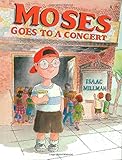Lessons & Units :: Moses Goes to a Concert Kindergarten Unit
Read-Aloud Lesson: Moses Goes to a Concert
Lesson Plan
Moses Goes to a Concert | 670L

- Learning Goal
- Demonstrate understanding of the main idea by describing how Moses and his classmates experience and enjoy music.
- Duration
- Part 1: Approximately 20 minutesPart 2: Approximately 10-15 minutesPart 3: Approximately 10-15 minutes
- Necessary Materials
Provided:
1. Detailed lesson plan
2. Graphic organizer for guided practice
3. Independent student worksheetNot Provided:
Moses Goes to a Concert
-
This lesson is a close reading of the entire text. So it’s important to engage students often, to enhance their learning. Here are two tips:
- When you ask the more complex questions from the lesson, ask students to “turn-and-talk” or “buddy-talk” before answering.
-
Once you are deep into the lesson, instead of asking students every question provided, ask them to share with you what questions they should be asking themselves at that point in the text. This is also a great opportunity to use "turn-and-talk."
- Suggested teacher language is included in the lesson.
- We recommend you read the book once to your students, either the day or morning before teaching the lesson.
- This research-based, read-aloud lesson may seem long. Why do students need the lesson to be this way?
Part 1: Teacher Modeling & Questioning
Write the following student-friendly learning goal on the board, then read the learning goal out loud with the class:
We will describe how Moses and his classmates experience the music.
Prepare Students for the Lesson
Please be sure that all of the students in the class know that if someone is deaf, he or she cannot hear sounds.
Sign language is demonstrated throughout the book in various illustrations. However, to achieve the learning goal of this specific lesson, there is not a focus on the sign language illustrations that appear throughout the book.
Transition Students into the Text
Teacher says:
- Everybody, take one of your hands and put it gently on the front of your throat.
- Do you feel anything? Keep your hand there and say “ahhhhh.”
- Did you feel anything different?
- What you felt in your hand was the vibration made by the sound of your voice when you said “ahhhhh.”
- Vibrations are important in the book we’re going to read, about a boy named Moses [show the cover of the book].
Read pages 1 and 2 out loud, then stop. Page 2 ends with, “...feel it through his feet, too”. Show illustrations.
1.
Teacher asks: Is Moses able to hear the sounds he is making on his new drum through his ears?
Students answer: No, Moses is not able to hear the sounds he is making on his new drum.
2.
Teacher asks: Why can’t Moses hear the sounds he is making on his drum?
Students answer: Moses can’t hear the sounds he is making on his drum because he is deaf.
3.
Teacher asks: Although Moses can’t hear the sounds of the drum, what can Moses feel?
Students answer: Moses can feel the vibration of the drum.
4.
Teacher asks: Through what parts of his body can Moses feel the vibration of the drum?
Students answer: Moses can feel the vibration of the drum through his hands and through his feet.
Part 2: Guided Practice & Discussion
For this oral lesson, it is suggested to have the completed graphic organizer on the board with the answers concealed before this part of the lesson. After students provide a correct answer, reveal the corresponding answer on the graphic organizer.
Transition Students into Guided Practice
1.
Teacher says: Let’s retell parts of the story and discuss how Moses and his classmates were able to experience and enjoy music.
2.
Teacher asks: Remember the very beginning of the book when Moses is in his house? What instrument is Moses playing?
Students answer: Moses is playing the drum.
3.
Teacher says: We read that Moses and his classmates are deaf.
4.
Teacher asks: What does it mean that Moses and his classmates are deaf?
Students answer: It means that Moses and his classmates can’t hear.
5.
Teacher asks: How can Moses feel or experience the music of the drum if he is deaf?
Students answer: He feels the vibration of the sound through his hands and through his feet, or through a balloon.
Student Independent Practice
Read each question out loud to your students and have each student complete the worksheet independently. For questions 5 A) and 6, you can have students draw their answers, answer orally, or write their answers depending on your students’ progress. If you have them write their answers, you may want to write the word(s) on the board for them to copy.
Texts & Materials
Standards Alignment
(To see all of the ReadWorks lessons aligned to your standards, click here.)





Thank you very much! This is very helpful.
These are amazing! Thank you so much for providing a well aligned, complete lesson for comprehension! These are wonderful!
I am a speech and language therapist and I love using the lessons that you supply. Read Works is and invaluable source for teaching comprehension in every grade. The publishers have made it easy to do so with the questions already posed. Thank you very much.